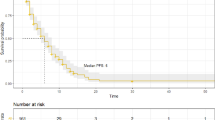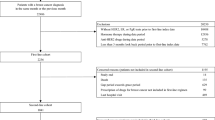Abstract
Tipifarnib (T) is a farnesyl transferase inhibitor (FTI) that enhances the antineoplastic effects of cytotoxic therapy in vitro, has activity in metastatic breast cancer, and enhances the pathologic complete response (pCR) rate to neoadjuvant doxorubicin–cyclophosphamide (AC) chemotherapy. We, therefore, performed a phase I–II trial of T plus neoadjuvant sequential weekly paclitaxel and 2-week AC chemotherapy in locally advanced breast cancer. Eligible patients with HER2-negative clinical stage IIB–IIIC breast cancer received 12 weekly doses of paclitaxel (80 mg/m2) followed by AC (60/600 mg/m2 every 2 weeks and filgrastim), plus T (100 or 200 mg PO on days 1–3 of each P dose, and 200 mg PO on days 2–7 of each AC cycle). The trial was powered to detect an improvement in breast pCR rate from 15 to 35 % (α = 0.10, β = 0.10) in two strata, including ER and/or PR-positive, non-inflammatory (stratum A) and inflammatory carcinoma (stratum B). Of the 60 patients accrued, there were no dose-limiting toxicities among the first six patients treated at the first T dose level (100 mg BID; N = 3) or second T dose level (200 mg BID; N = 3) plus paclitaxel. Breast pCR occurred in 6/33 patients (18 %, 95 % confidence intervals (CI) 7–36 %) and 1/22 patients (4 %, 95 % CI 0–8 %) in stratum B. Combination of the FTI T with weekly paclitaxel–AC is unlikely to be associated with a breast pCR rate of 35 % or higher in patients with locally advanced HER2/neu-negative inflammatory or non-inflammatory ER- and/or PR-positive breast carcinoma.
Similar content being viewed by others
References
Rochlitz CF, Scott GK, Dodson JM et al (1989) Incidence of activating ras oncogene mutations associated with primary and metastatic human breast cancer. Cancer Res 49:357–360
Thor A, Ohuchi N, Hand PH et al (1986) ras gene alterations and enhanced levels of ras p21 expression in a spectrum of benign and malignant human mammary tissues. Lab Invest 55:603–615
Smith CA, Pollice AA, Gu LP et al (2000) Correlations among p53, Her-2/neu, and ras overexpression and aneuploidy by multiparameter flow cytometry in human breast cancer: evidence for a common phenotypic evolutionary pattern in infiltrating ductal carcinomas. Clin Cancer Res 6:112–126
Bunone G, Briand PA, Miksicek RJ et al (1996) Activation of the unliganded estrogen receptor by EGF involves the MAP kinase pathway and direct phosphorylation. EMBO J 15:2174–2183
Kato S, Masuhiro Y, Watanabe M et al (2000) Molecular mechanism of a cross-talk between oestrogen and growth factor signalling pathways. Genes Cells 5:593–601
Theillet C, Lidereau R, Escot C et al (1986) Loss of a c-H-ras-1 allele and aggressive human primary breast carcinomas. Cancer Res 46:4776–4781
Kleer CG, van Golen KL, Zhang Y et al (2002) Characterization of RhoC expression in benign and malignant breast disease: a potential new marker for small breast carcinomas with metastatic ability. Am J Pathol 160:579–584
van Golen KL, Bao L, DiVito MM et al (2002) Reversion of RhoC GTPase-induced inflammatory breast cancer phenotype by treatment with a farnesyl transferase inhibitor. Mol Cancer Ther 1:575–583
Zhu K, Hamilton AD, Sebti SM (2003) Farnesyltransferase inhibitors as anticancer agents: current status. Curr Opin Investig Drugs 4:1428–1435
Crespo NC, Ohkanda J, Yen TJ et al (2001) The farnesyltransferase inhibitor, FTI-2153, blocks bipolar spindle formation and chromosome alignment and causes prometaphase accumulation during mitosis of human lung cancer cells. J Biol Chem 276:16161–16167
Crespo NC, Delarue F, Ohkanda J et al (2002) The farnesyltransferase inhibitor, FTI-2153, inhibits bipolar spindle formation during mitosis independently of transformation and Ras and p53 mutation status. Cell Death Differ 9:702–709
Ashar HR, James L, Gray K et al (2001) The farnesyl transferase inhibitor SCH 66336 induces a G(2) → M or G(1) pause in sensitive human tumor cell lines. Exp Cell Res 262:17–27
Sepp-Lorenzino L, Rosen N (1998) A farnesyl-protein transferase inhibitor induces p21 expression and G1 block in p53 wild type tumor cells. J Biol Chem 273:20243–20251
Le Gouill S, Pellat-Deceunynck C, Harousseau JL et al (2002) Farnesyl transferase inhibitor R115777 induces apoptosis of human myeloma cells. Leukemia 16:1664–1667
Han JY, Oh SH, Morgillo F et al (2005) Hypoxia-inducible factor 1alpha and antiangiogenic activity of farnesyltransferase inhibitor SCH66336 in human aerodigestive tract cancer. J Natl Cancer Inst 97:1272–1286
Kelland LR, Smith V, Valenti M et al (2001) Preclinical antitumor activity and pharmacodynamic studies with the farnesyl protein transferase inhibitor R115777 in human breast cancer. Clin Cancer Res 7:3544–3550
Sun J, Ohkanda J, Coppola D et al (2003) Geranylgeranyltransferase I inhibitor GGTI-2154 induces breast carcinoma apoptosis and tumor regression in H-Ras transgenic mice. Cancer Res 63:8922–8929
Kohl NE, Omer CA, Conner MW et al (1995) Inhibition of farnesyltransferase induces regression of mammary and salivary carcinomas in ras transgenic mice. Nat Med 1:792–797
Marcus AI, Zhou J, O’Brate A et al (2005) The synergistic combination of the farnesyl transferase inhibitor lonafarnib and paclitaxel enhances tubulin acetylation and requires a functional tubulin deacetylase. Cancer Res 65:3883–3893
Loprevite M, Favoni RE, De Cupis A et al (2004) In vitro study of farnesyltransferase inhibitor SCH 66336, in combination with chemotherapy and radiation, in non-small cell lung cancer cell lines. Oncol Rep 11:407–414
Wang EJ, Johnson WW (2003) The farnesyl protein transferase inhibitor lonafarnib (SCH66336) is an inhibitor of multidrug resistance proteins 1 and 2. Chemotherapy 49:303–308
Jin W, Wu L, Liang K et al (2003) Roles of the PI-3K and MEK pathways in Ras-mediated chemoresistance in breast cancer cells. Br J Cancer 89:185–191
Weinstein-Oppenheimer CR, Henriquez-Roldan CF, Davis JM et al (2001) Role of the Raf signal transduction cascade in the in vitro resistance to the anticancer drug doxorubicin. Clin Cancer Res 7:2898–2907
Rasouli-Nia A, Liu D, Perdue S et al (1998) High Raf-1 kinase activity protects human tumor cells against paclitaxel-induced cytotoxicity. Clin Cancer Res 4:1111–1116
Cornwell MM, Smith DE (1993) A signal transduction pathway for activation of the mdr1 promoter involves the proto-oncogene c-raf kinase. J Biol Chem 268:15347–15350
Johnston SR, Hickish T, Ellis P et al (2003) Phase II study of the efficacy and tolerability of two dosing regimens of the farnesyl transferase inhibitor, R115777, in advanced breast cancer. J Clin Oncol 21:2492–2499
Sparano JA, Moulder S, Kazi A et al (2006) Targeted inhibition of farnesyltransferase in locally advanced breast cancer: a phase I and II trial of tipifarnib plus dose-dense doxorubicin and cyclophosphamide. J Clin Oncol 24:3013–3018
Sparano JA, Moulder S, Kazi A et al (2009) Phase II trial of tipifarnib plus neoadjuvant doxorubicin–cyclophosphamide in patients with clinical stage IIB–IIIC breast cancer. Clin Cancer Res 15:2942–2948
Bear HD, Anderson S, Brown A et al (2003) The effect on tumor response of adding sequential preoperative docetaxel to preoperative doxorubicin and cyclophosphamide: preliminary results from National Surgical Adjuvant Breast and Bowel Project Protocol B-27. J Clin Oncol 21:4165–4174
Green MC, Buzdar AU, Smith T et al (2005) Weekly paclitaxel improves pathologic complete remission in operable breast cancer when compared with paclitaxel once every 3 weeks. J Clin Oncol 23:5983–5992
Sparano JA, Wang M, Martino S et al (2008) Weekly paclitaxel in the adjuvant treatment of breast cancer. N Engl J Med 358:1663–1671
Therasse P, Arbuck SG, Eisenhauer EA et al (2000) New guidelines to evaluate the response to treatment in solid tumors. European Organization for Research and Treatment of Cancer, National Cancer Institute of the United States, National Cancer Institute of Canada. J Natl Cancer Inst 92:205–216
Symmans WF, Peintinger F, Hatzis C et al (2007) Measurement of residual breast cancer burden to predict survival after neoadjuvant chemotherapy. J Clin Oncol 25:4414–4422
Guarneri V, Broglio K, Kau SW et al (2006) Prognostic value of pathologic complete response after primary chemotherapy in relation to hormone receptor status and other factors. J Clin Oncol 24:1037–1044
Kuerer HM, Newman LA, Smith TL et al (1999) Clinical course of breast cancer patients with complete pathologic primary tumor and axillary lymph node response to doxorubicin-based neoadjuvant chemotherapy. J Clin Oncol 17:460–469
Prowell TM, Pazdur R (2012) Pathological complete response and accelerated drug approval in early breast cancer. N Engl J Med 366:2438–2441
Prowell TM, Pazdur R (2012) Pathological complete response and accelerated drug approval in early breast cancer. N Engl J Med 366:2438–2441
Barker AD, Sigman CC, Kelloff GJ et al (2009) I-SPY 2: an adaptive breast cancer trial design in the setting of neoadjuvant chemotherapy. Clin Pharmacol Ther 86:97–100
Cortazar P, Zhang L, Untch M et al (2012) Meta-Analysis results from the collaborative trials in neoadjuvant breast cancer (CTNeoBC). Breast Cancer Res Treat 72:S1–11, 2012
Esserman LJ, Berry DA, Cheang MC et al (2012) Chemotherapy response and recurrence-free survival in neoadjuvant breast cancer depends on biomarker profiles: results from the I-SPY 1 TRIAL (CALGB 150007/150012; ACRIN 6657). Breast Cancer Res Treat 132:1049–1062
Houssami N, Macaskill P, von Minckwitz G et al (2012) Meta-analysis of the association of breast cancer subtype and pathologic complete response to neoadjuvant chemotherapy. Eur J Cancer 48:3342–3354
Acknowledgments
Supported by United States Department of Health and Human Service contract N01-CM-62204 (P. I. Joseph A. Sparano, MD) and Grant RO1CA98473 (P. I. Said Sebti, PhD, co-PI: Joseph A. Sparano, MD).
Conflict of interest
The authors have no financial disclosures with the exception of Dr. Sparano, who serves as a paid consultant to Johnson & Johnson.
Author information
Authors and Affiliations
Corresponding author
Additional information
This study was conducted on behalf of New York Cancer Consortium and collaborating institutions.
Rights and permissions
About this article
Cite this article
Andreopoulou, E., Vigoda, I.S., Valero, V. et al. Phase I–II study of the farnesyl transferase inhibitor tipifarnib plus sequential weekly paclitaxel and doxorubicin–cyclophosphamide in HER2/neu-negative inflammatory carcinoma and non-inflammatory estrogen receptor-positive breast carcinoma. Breast Cancer Res Treat 141, 429–435 (2013). https://doi.org/10.1007/s10549-013-2704-x
Received:
Accepted:
Published:
Issue Date:
DOI: https://doi.org/10.1007/s10549-013-2704-x




